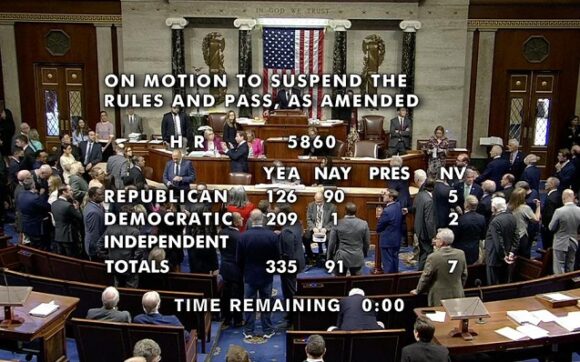Dear Commons Community,
Americans view college campuses as far friendlier to liberals than to conservatives when it comes to free speech, with adults across the political spectrum seeing less tolerance for those on the right, according to a new poll.
Overall, 47% of adults say liberals have “a lot” of freedom to express their views on college campuses, while just 20% said the same of conservatives, according to polling from the University of Chicago and The Associated Press-NORC Center for Public Affairs Research.
Republicans perceive a stronger bias on campuses against conservatives, but Democrats see a difference too — about 4 in 10 Democrats say liberals can speak their minds freely on campuses, while about 3 in 10 Democrats say conservatives can do so.
“If you’re a Republican or lean Republican, you’re unabashedly wrong, they shut you down,” said Rhonda Baker, 60, of Goldsboro, North Carolina, who voted for former President Donald Trump and has a son in college. “If they hold a rally, it’s: ‘The MAGA’s coming through.’ It’s: ‘The KKK is coming through.’”
Debates over First Amendment rights have occasionally flared on college campuses in recent years, with conflicts arising over guest speakers who express polarizing views, often from the political right.
Stanford University became a flashpoint this year when students shouted down a conservative judge who was invited to speak. More recently, a conservative Princeton University professor was drowned out while discussing free speech at Washington College, a small school in Maryland.
At the same time, Republican lawmakers in dozens of states have proposed bills aiming to limit public colleges from teaching topics considered divisive or liberal. Just 30% of Americans say states should be able to restrict what professors at state universities teach, the poll found, though support was higher among Republicans.
Overall, Republicans see a clear double standard on college campuses. Just 9% said conservatives can speak their minds, while 58% said liberals have that freedom, according to the polling. They were also slightly less likely than Americans overall to see campuses as respectful and inclusive places for conservatives.
Chris Gauvin, a Republican who has done construction work on campuses, believes conservative voices are stifled. While working at Yale University, he was once stopped by pro-LGBTQ+ activists who asked for his opinion, he said.
“They asked me how I felt, so I figured I’d tell them. I spoke in a normal tone, I didn’t get excited or upset,” said Gauvin, 58, of Manchester, Conn. “But it proceeded with 18 to 20 people who were suddenly very irritated and agitated. It just exploded.”
He took a lesson from the experience: “I learned to be very quiet there.”
Republicans in Congress have raised alarms, with a recent House report warning of “the long-standing and pervasive degradation of First Amendment rights” at U.S. colleges. Some in the GOP have called for federal legislation requiring colleges to protect free speech and punish those who infringe on others’ rights.
Nicholas Fleisher, who chairs an academic freedom committee for the American Association of University Professors, said public perception is skewed by the infrequent cases when protesters go too far.
“The reality is that there’s free speech for everyone on college campuses,” said Fleisher, a linguistics professor at the University of Wisconsin, Milwaukee. “In conversations within classrooms, people are free to speak their minds. And they do.”
Officials at PEN America, a free speech group, say most students welcome diverse views. But as the nation has become more politically divided, so have college campuses, said Kristen Shahverdian, senior manager for education at PEN.
“There’s this polarization that just continues to grow and build across our country, and colleges and universities are a part of that ecosystem,” she said.
Morgan Ashford, a Democrat in an online graduate program at Troy University in Alabama, said she thinks people can express themselves freely on campus regardless of politics or skin color. Still, she sees a lack of tolerance for the LGBTQ+ community in her Republican state where the governor has passed anti-LGBTQ legislation.
“I think there have to be guidelines” around hate speech, said Ashford. “Because some people can go overboard.”
When it comes to protesting speakers, most Americans say it should be peaceful. About 8 in 10 say it’s acceptable to engage in peaceful, non-disruptive protest at a campus event, while just 15% say it’s OK to prevent a speaker from communicating with the audience, the poll found.
“If they don’t like it, they can get up and walk out,” said Linda Woodward, 71, a Democrat in Hot Springs Village, Arkansas.
Mike Darlington, a real estate appraiser who votes Republican, said drowning out speakers violates the virtues of a free society.
“It seems to me a very, very selfish attitude that makes students think, ‘If you don’t think the way I do, then your thoughts are unacceptable,’” said Darlington, 58, of Chesterfield County, Virginia.
The protest at Stanford was one of six campus speeches across the U.S. that ended in significant disruption this year, with another 11 last year, according to a database by the Foundation for Individual Rights and Expression, a free speech group.
Those cases, while troubling, are one symptom of a broader problem, said Ilya Shapiro, a conservative legal scholar who was shouted down during a speech last year at the University of California’s law school. He says colleges have drifted away from the classic ideal of academia as a place for free inquiry.
An even bigger problem than speakers being disrupted by protesters is “students and faculty feeling that they can’t be open in their views. They can’t even discuss certain subjects,” said Shapiro, director of constitutional studies at the Manhattan Institute think tank.
About three in five Americans (62%) say that a major purpose of higher education is to support the free exchange and debate of different ideas and values. Even more U.S. adults say college’s main purpose is to teach students specific skills (82%), advance knowledge and ideas (78%) or teach students to be critical thinkers (76%). Also, 66% said a major purpose is to create a respectful and inclusive learning environment.
“I believe it should be solely to prepare you to enter the workforce,” said Gene VanZandt, 40, a Republican who works in shipbuilding in Hampton, Virginia. “I think our colleges have gone too far off the path of what their function was.”
The poll finds that majorities of Americans think students and professors, respectively, should not be allowed to express racist, sexist or anti-LGBTQ views on campus, with slightly more Republicans than Democrats saying those types of views should be allowed. There was slightly more tolerance for students expressing those views than for professors.
About 4 in 10 said students should be permitted to invite academic speakers accused of using offensive speech, with 55% saying they should not. There was a similar split when asked whether professors should be allowed to invite those speakers.
Darlington believes students and professors should be able to discuss controversial topics, but there are limits.
“Over-the-top, overtly racist, hateful stuff — no. You shouldn’t be allowed to do that freely,” he said.
The poll of 1,095 adults was conducted Sept. 7-11, 2023, using a sample drawn from NORC’s probability-based AmeriSpeak Panel, which is designed to be representative of the U.S. population. The margin of sampling error for all respondents is plus or minus 4 percentage points.
Tony










